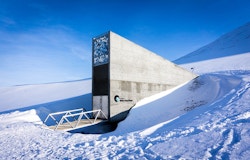In Svalbard, memory of 13,000 years of biodiversity
Energy Observer is becoming the first vessel in the world to join the Arctic Circle, only powered by renewable energy and hydrogen. 2,400 miles to sail from St Petersburg to Spitsbergen, an iconic destination for many reasons.
This island in the Norwegian archipelago of Svalbard is deeply impacted by the climate change more than anywhere else on the planet. A phenomena that Energy Observer will report on during its Odyssey.
According to a study by researchers at Stockholm University published in the Nature Ecology & Evolution journal last June, three plant species have been disappearing from the face of the earth each year since 1900. A loss of biodiversity that has received little media coverage, but which could soon endanger ecosystems and deprive us of important sources of food and therapeutic molecules. Exposed to high levels of carbon dioxide, rice could lose its nutritional quality. With climate change, wheat yields are stagnating, maize production is declining. And 60% of wild coffee species are at risk of extinction.
It is precisely in an attempt to preserve the genetic diversity of plants in our biosphere that more than 1,500 seed banks have been created around the world. Among them, the Svalbard Seed Vault, considered as the safest, from a geological, environmental and geopolitical point of view. Dug into the side of a mountain on the island of Spitsbergen, this reserve has been home to food crop seeds from all over the world for more than ten years. A record of more than one million different varieties was even reached in 2018.

Svalbard Seed Vault
Preserving plant biodiversity
This plant Noah’s Ark consists of a deep cavity dug in the permafrost to help preserve the seeds. And about 130 metres above sea level to protect them from melting ice. In all, these are three cavities capable of holding 1.5 million seeds each, maintained by refrigeration units at an optimal temperature of -18°C.
Objective: to preserve the biodiversity of a regional or even global disaster, but above all, to compensate for the shortcomings of other seed banks that are more likely to be affected by breakdowns, natural disasters or wars. A mission that this global reserve is currently fulfilling perfectly.
For example, the seed collection entrusted to the Svalbard vault in the early 2010’s in the midst of the Syrian civil war by agronomists from the International Centre for Agricultural Research in Arid Zones (Icarda). The largest seed collection in the Middle East is now gradually returning to its original lands.
Seeds that are definitely safe?
Despite all the precautions taken to provide an inviolable arch with precious seeds, the global seed supply of Svalbard showed a weakness in 2017. Climate change has caused an unexpected melting of permafrost. And a flood of the “Last Judgment vault” as some call it. Fortunately, there are no consequences for the seed reserves.
Our Spitsbergen series
[Spitsbergen Objective] Ground zero of climate change
[Spitsbergen Objective] What are the consequences of melting ice?
To go further
Long travelled seeds in place in the Seed Vault – Svalbard Global Seed Vault
15 Crops Secured in the Svalbard Global Seed Vault – Foodtank
Le Grenier de la planète fête ses 10 ans : près d’un million de graines conservées sous la glace – France TV Info
The world’s ‘doomsday seed vault’ is built to store every crop on the planet, but the icy area that protects it is at risk – Business Insider
Cherokee Nation invited to store seeds in Arctic vault – Cherokee Phoenix